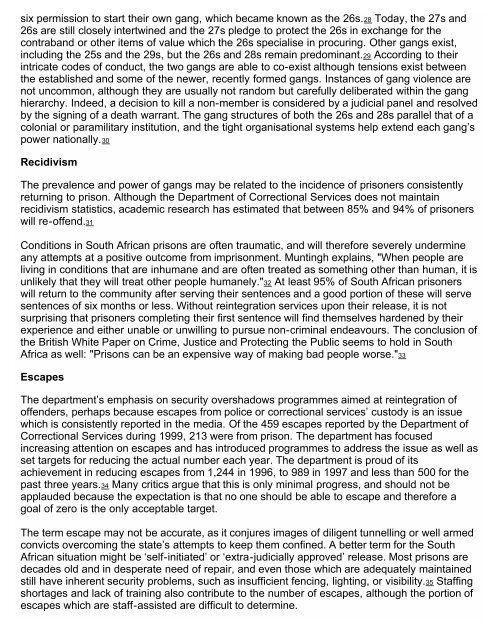prison privatisation in south africa issues, challenges and ...
prison privatisation in south africa issues, challenges and ...
prison privatisation in south africa issues, challenges and ...
You also want an ePaper? Increase the reach of your titles
YUMPU automatically turns print PDFs into web optimized ePapers that Google loves.
six permission to start their own gang, which became known as the 26s.28 Today, the 27s <strong>and</strong><br />
26s are still closely <strong>in</strong>tertw<strong>in</strong>ed <strong>and</strong> the 27s pledge to protect the 26s <strong>in</strong> exchange for the<br />
contrab<strong>and</strong> or other items of value which the 26s specialise <strong>in</strong> procur<strong>in</strong>g. Other gangs exist,<br />
<strong>in</strong>clud<strong>in</strong>g the 25s <strong>and</strong> the 29s, but the 26s <strong>and</strong> 28s rema<strong>in</strong> predom<strong>in</strong>ant.29 Accord<strong>in</strong>g to their<br />
<strong>in</strong>tricate codes of conduct, the two gangs are able to co-exist although tensions exist between<br />
the established <strong>and</strong> some of the newer, recently formed gangs. Instances of gang violence are<br />
not uncommon, although they are usually not r<strong>and</strong>om but carefully deliberated with<strong>in</strong> the gang<br />
hierarchy. Indeed, a decision to kill a non-member is considered by a judicial panel <strong>and</strong> resolved<br />
by the sign<strong>in</strong>g of a death warrant. The gang structures of both the 26s <strong>and</strong> 28s parallel that of a<br />
colonial or paramilitary <strong>in</strong>stitution, <strong>and</strong> the tight organisational systems help extend each gang’s<br />
power nationally.30<br />
Recidivism<br />
The prevalence <strong>and</strong> power of gangs may be related to the <strong>in</strong>cidence of <strong>prison</strong>ers consistently<br />
return<strong>in</strong>g to <strong>prison</strong>. Although the Department of Correctional Services does not ma<strong>in</strong>ta<strong>in</strong><br />
recidivism statistics, academic research has estimated that between 85% <strong>and</strong> 94% of <strong>prison</strong>ers<br />
will re-offend.31<br />
Conditions <strong>in</strong> South African <strong>prison</strong>s are often traumatic, <strong>and</strong> will therefore severely underm<strong>in</strong>e<br />
any attempts at a positive outcome from im<strong>prison</strong>ment. Munt<strong>in</strong>gh expla<strong>in</strong>s, "When people are<br />
liv<strong>in</strong>g <strong>in</strong> conditions that are <strong>in</strong>humane <strong>and</strong> are often treated as someth<strong>in</strong>g other than human, it is<br />
unlikely that they will treat other people humanely."32 At least 95% of South African <strong>prison</strong>ers<br />
will return to the community after serv<strong>in</strong>g their sentences <strong>and</strong> a good portion of these will serve<br />
sentences of six months or less. Without re<strong>in</strong>tegration services upon their release, it is not<br />
surpris<strong>in</strong>g that <strong>prison</strong>ers complet<strong>in</strong>g their first sentence will f<strong>in</strong>d themselves hardened by their<br />
experience <strong>and</strong> either unable or unwill<strong>in</strong>g to pursue non-crim<strong>in</strong>al endeavours. The conclusion of<br />
the British White Paper on Crime, Justice <strong>and</strong> Protect<strong>in</strong>g the Public seems to hold <strong>in</strong> South<br />
Africa as well: "Prisons can be an expensive way of mak<strong>in</strong>g bad people worse."33<br />
Escapes<br />
The department’s emphasis on security overshadows programmes aimed at re<strong>in</strong>tegration of<br />
offenders, perhaps because escapes from police or correctional services’ custody is an issue<br />
which is consistently reported <strong>in</strong> the media. Of the 459 escapes reported by the Department of<br />
Correctional Services dur<strong>in</strong>g 1999, 213 were from <strong>prison</strong>. The department has focused<br />
<strong>in</strong>creas<strong>in</strong>g attention on escapes <strong>and</strong> has <strong>in</strong>troduced programmes to address the issue as well as<br />
set targets for reduc<strong>in</strong>g the actual number each year. The department is proud of its<br />
achievement <strong>in</strong> reduc<strong>in</strong>g escapes from 1,244 <strong>in</strong> 1996, to 989 <strong>in</strong> 1997 <strong>and</strong> less than 500 for the<br />
past three years.34 Many critics argue that this is only m<strong>in</strong>imal progress, <strong>and</strong> should not be<br />
applauded because the expectation is that no one should be able to escape <strong>and</strong> therefore a<br />
goal of zero is the only acceptable target.<br />
The term escape may not be accurate, as it conjures images of diligent tunnell<strong>in</strong>g or well armed<br />
convicts overcom<strong>in</strong>g the state’s attempts to keep them conf<strong>in</strong>ed. A better term for the South<br />
African situation might be ‘self-<strong>in</strong>itiated’ or ‘extra-judicially approved’ release. Most <strong>prison</strong>s are<br />
decades old <strong>and</strong> <strong>in</strong> desperate need of repair, <strong>and</strong> even those which are adequately ma<strong>in</strong>ta<strong>in</strong>ed<br />
still have <strong>in</strong>herent security problems, such as <strong>in</strong>sufficient fenc<strong>in</strong>g, light<strong>in</strong>g, or visibility.35 Staff<strong>in</strong>g<br />
shortages <strong>and</strong> lack of tra<strong>in</strong><strong>in</strong>g also contribute to the number of escapes, although the portion of<br />
escapes which are staff-assisted are difficult to determ<strong>in</strong>e.
















